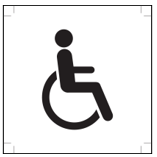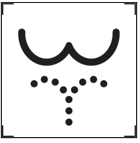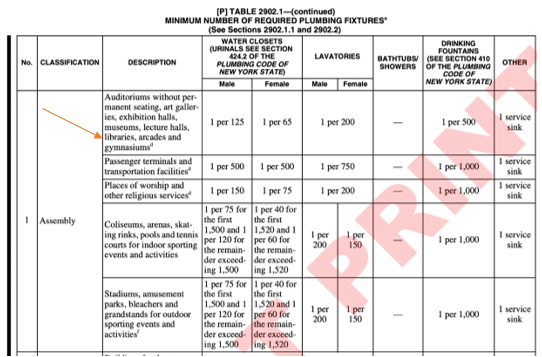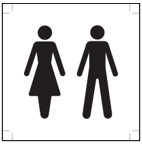Submission Date:
Question:
Some of my member libraries have questions about the new Gender Neutral Bathroom Legislation:
1) Type of signage required to be placed on or near the bathroom door. That is, does the sign have to specify "gender neutral", or, is "bathroom" ok. Also, can one use a sign that uses symbols (male, female, ADA) rather than sex?
2) Is a library required to have at least one designated male and one designated female bathroom in the building in addition to a gender neutral one? One of my libraries was with 3 bathrooms was told that was the case.
3) Is there a height requirement for braille signs so that individuals who use wheelchairs can reach it?
[This is the part of the legislation that is generating questions: "Such gender neutral bathroom facilities shall be clearly designated by the posting of such on or near the entry door of each facility."]
It will be good to have clarification/interpretation; it sounds like it has to be clearly stated as gender neutral, which likely can be done with signs with the symbols, but you never know.
Thank you in advance for providing clarification on this legislation.
Answer:
Above all, "Ask the Lawyer" strives to provide useful, plain-language legal information and analysis for the members of New York's regional library councils.
So before I delve into the background, legal analysis, and compliance tips I would like to offer in response to these questions, here are some useful, plain-language answers:
- The posted signage must specify that the single-occupancy bathroom is "gender neutral;"
- Symbols are allowed only if they effectively convey that the bathroom is "gender neutral";
- Amounts and ratios of toilet facilities depend on the type and size of the library;
- Yes, there is a defined standard-height requirement for Braille signs designating a public bathroom.
And with that said...let's delve.
Background
First, let's check in with the legislation[1] the member references, which was signed into law in December 2020, and went into effect in March 2021.
Called "AN ACT to amend the civil rights law and the education law, in relation to single-occupancy bathroom facilities," this legislation affects not only bathrooms in public spaces (like bars, restaurants, etc.), but also bathrooms in SUNY, CUNY, and all community colleges.[2]
While the title and the text of the new laws may sound a tad dry, the "legislative memo" that accompanied it left no room for doubt as to the law-makers' aspirations:
Access to public spaces should not be a privilege. A person's sexual orientation and gender identity are not justifications to exclude individuals from public spaces, including bathrooms. The argument that transgender individuals must use the restroom that corresponds with their assigned gender at birth is discriminatory and wrong. New York State has been a safe haven for people from all backgrounds and beliefs, and we must recognize our role as a leader in the fight for transgender rights. Expanding the civil liberties of transgender individuals is a task New York must take up with pride. We must acknowledge that this issue is not about bathrooms, but is instead about fighting for a person's right to exist in the world free from harassment and discrimination. The California legislature recently passed the most progressive bill on bathroom access in the nation. Now is an opportunity for New York to join California in its efforts to protect transgender individuals and expand inclusivity and dignity for all. Modeled after
California's bill, this act would require all publicly accessible bathrooms, including those in public and private schools, restaurants, bars, mercantile establishments, factories or state-owned or operated buildings, to designate all single occupancy bathrooms as gender neutral.
The memo makes it crystal clear: the intent of the act is to protect civil rights.
This background is important to consider, because as we analyze how to comply with the new laws, the lawmakers' intent--sometimes called the "spirit" of the law--is relevant.
Legal Analysis
Any institution that must comply with the Americans with Disabilities Act ("ADA")[3] should use the United States Department of Justice (USDOJ)'s standards for accessible design, including when creating the now-required postings to designate gender-neutral[4] bathrooms.
The USDOJ's ADA standards are silent about gender-neutral space. However, they do set parameters for signage, including, as the member writes, use and placement of Braille and signs with "tactile" (can be discerned through touch) elements.
Among what is required (sorry if this language is opaque, I don't write the guidance, I just quote it):
Tactile text descriptors are required for pictograms that are provided to label or identify a permanent room or space. Pictograms that provide information about a room or space, such as "no smoking," occupant logos, and the International Symbol of Accessibility, are not required to have text descriptors.
And
703.4.2 Location. Where a tactile sign is provided at a door, the sign shall be located alongside the door at the latch side. Where a tactile sign is provided at double doors with one active leaf, the sign shall be located on the inactive leaf. Where a tactile sign is provided at double doors with two active leafs, the sign shall be located to the right of the right hand door. Where there is no wall space at the latch side of a single door or at the right side of double doors, signs shall be located on the nearest adjacent wall. Signs containing tactile characters shall be located so that a clear floor space of 18 inches (455 mm) minimum by 18 inches (455 mm) minimum, centered on the tactile characters, is provided beyond the arc of any door swing between the closed position and 45 degree open position.
And
703.4.1 Height Above Finish Floor or Ground. Tactile characters on signs shall be located 48 inches (1220 mm) minimum above the finish floor or ground surface, measured from the baseline of the lowest tactile character and 60 inches (1525 mm) maximum above the finish floor or ground surface, measured from the baseline of the highest tactile character.
Meanwhile, in the State of New York, the State Building Code Section E 107.3 reinforces these signage requirements. [NOTE: This link was confirmed as no longer active and removed on 02/25/2022 as part of the routine review of "Ask the Lawyer" materials.]
What does all this mean? Ideally, the posted signage designating a gender-neutral, single-occupancy or family assist restroom should have either a pictogram with a tactile element on it, or Braille text descriptors describing the room, and with regard to placement, that sign's center should be no less than four feet and no more than five feet above the floor.
Now, let's talk about symbols (as opposed to words).
What if your library wants to use a symbol (or "pictogram") instead of the phrase "gender-neutral"? This is a tough one. If you still have those USDOJ ADA standards open, take a look at how they refer to use of symbols.
First, you'll see that there is a "universal" symbol, set by the International Organization for Standardization (the "ISO"[5]) for designating a bathroom that meets the standards for wheelchair access:[6]

Use of this "universal" symbol is described in both the USDOJ ADA guidelines, and the NY State Building Code.
Next, you'll see that the ISO does have a symbol they have developed to designate that a bathroom is "unisex":
Now, this is just me saying this, so take it with a grain of "persnickety lawyer" salt, but "unisex" is not the same as "gender neutral." Further, a symbol combining the binary designations for "female" and "male" is not quite consistent with an initiative seeking to respect the innate dignity of people who might not identify with either category.[7]
So, until the ISO develops a symbol for "gender-neutral" that doesn't rely on a binary construct of gender, I advise considering not using a symbol at all (for the "gender-neutral") part. Give the ISO time to craft a more appropriate pictogram.
That said, if you are a library lucky enough to have a bidet in your single-occupancy, gender-neutral, family-assist bathroom, the ISO might still have an option for the "bidet" part:[8]

--Just make sure that as required, the pictogram has a tactile element.
Compliance tips
With the legislative record clearly establishing that this change to the law is about civil rights, and with libraries eager to emphasize their missions of access and inclusivity, the signage for a library's gender-neutral bathroom is a good one to demonstrably get right.
However, as you can see from the "Legal Analysis" above, "getting it right" can be complex.
As just a final example of that complexity (and to delve a bit more into one of the member's questions) here is a section of the New York State Building Code's Section 2902, on the prescribed ratio of plumbing facilities for libraries (including total amount of lavatories, amount for men, and amount for women[9]):

What is the take-away from this chart? If your library is struggling with how to designate, plan, or build the right number and/or type of bathrooms, don't be surprised: this stuff is not simple, and it takes consideration of old/new construction, your status as a tenant or building owner, local law, and a host of other factors. Which is why (in addition to your lawyer), a local architect, or a planner with experience on civic and public assembly spaces, is a good person to reach out to.
Architects and planners are the people who live and breathe place-making and ordinal signage. By design, these are professions that think about how people organize buildings, and how people can feel welcome in spaces. An architect or planner with experience in your area will know exactly how to not only designate the space, but to order the signage, and assess the required number of facilities. Since there is no "one size fits all" answer to some of these issues, a library needs to consider a custom fit.
If you aren't sure where to start on a quest for an architect or planner, a call to your local "Permits" officer might yield a name or two, and if there is a local college, their librarian might be able to connect you to the "head of planning."
Conclusion
I have included a lot of analysis in this answer, because in my experience an audience of information management professionals can handle it.
That said, after all the above analysis and commentary, the answers regarding a gender-neutral, single occupancy/family assist bathroom are simple:
- The posted signage must expressly specify that the single-occupancy bathroom is "gender neutral;"
- Symbols are allowed if they convey that the bathroom is gender neutral, but (my thoughts) the "official" symbols out there aren't 100% on point, so proceed with caution;
- Whether or not a library is required to have at least one designated male and one designated female bathroom in their building depends on the type and size of the library; consult a planner or licensed architect in your area if you are unsure;
- If you order ADA-compliant signage with Braille or a tactile element, affix the center of the sign between four and five feet from the floor, taking care to select a space that meets the USDOJ's requirements.
Thank you so much for a thoughtful array of questions, I was very grateful to be able to spend some time delving into this topic.
[1] On the NY Assembly site here.
[2] If you're thinking "Hey, they left out public schools!", the law impacting those was passed earlier.
[3] See ADA Compliance When Screening Movies for comments on when a library, museum or other institution must comply with the ADA.
[4] Confession: it is driving me CRAZY that this legislation did not include a hyphen between "gender" and "neutral." I refuse to continue the mistake and will use a hyphen unless I am directly quoting the law; to do otherwise would be to be "grammar-neutral" (not to be mistaken for a "grammar neutral" which is someone who mediates grammar disputes).
[5] An organization that is "famous" in the same way the G8 or the IMF is "famous": generally known, and pervasively powerful...but not many people can succinctly define what you do on a daily basis.
[6] Find more guidance on standards for using this symbol at ISO here: www.iso.org/obp/ui/#iso:grs:7001:PI_PF_003; the general search tool for international symbols is: https://www.iso.org/obp/ui/#home
[7] Get it together, ISO!
[8] Seriously, I am not kidding. It's right here.
[9] Section 2902 also states that any single-occupancy bathroom may be deducted proportionately from gender ratios. It's almost like they knew what was coming!
Tag:
Accessibility, Library Buildings, Building Codes, Gender Neutral Signage, Signage, Disability, ADA

